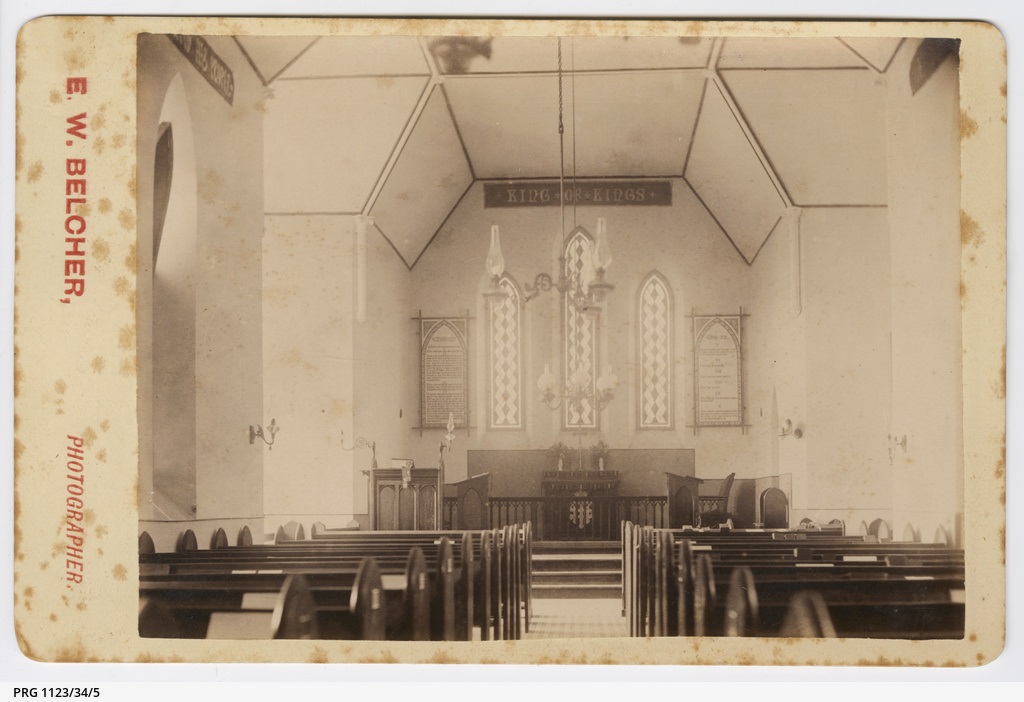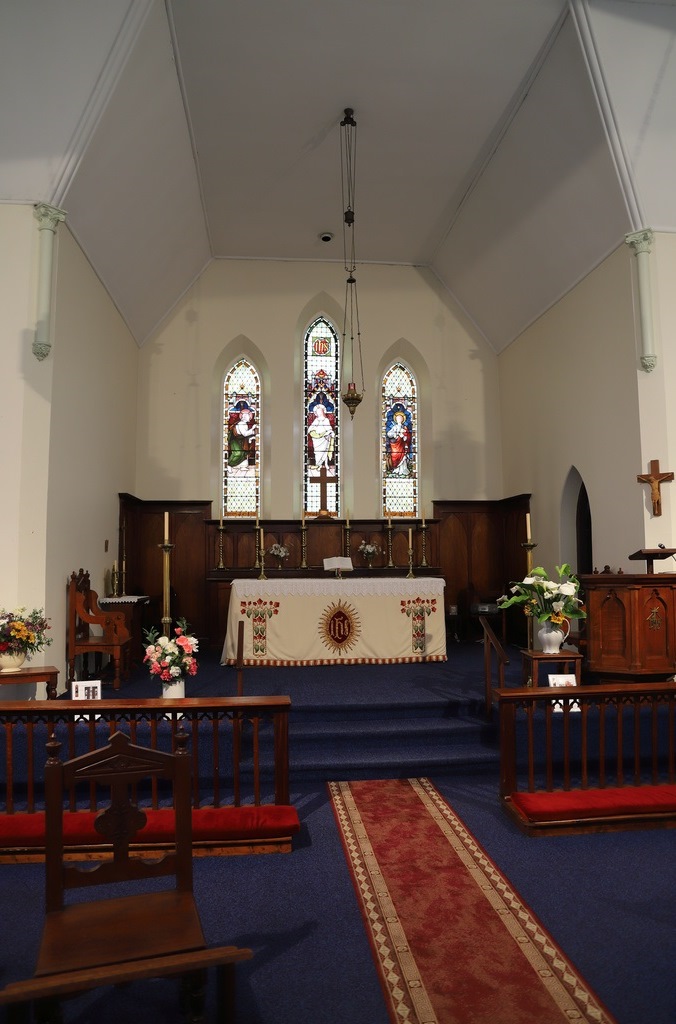George James Coates was born at Emerald Hill (South Melbourne) on the 9th August 1869, the son of John Robert Coates (1842-1877) and Elizabeth Mina Irwin (1847-1902).
His father died when he was eight years old and his mother allowed him to be apprenticed to the Ferguson & Urie stained glass company at age fifteen, circa 1884.
George studied at the North Melbourne School of Design and Hotham School of Art and attended classes under Frederick McCubbin. He won a scholarship in 1896 that enabled him to travel to London then Paris and in 1903 he married artist Dora Meeson (they had no issue). He was also the Australian Governments unofficial war artist during WW1.
In 1937 his wife Dora wrote his biography; George Coates, ‘His Art and His Life’, in which she makes minor mention of his time with the Ferguson & Urie stained glass company and that he had a distaste for the coarse jokes from the other employees.
In all of the Ferguson & Urie windows found to-date, it is impossible to know which of them, within George’s era at the company, may contain examples of his artwork. The exception to this may be in the house of his employer, James Ferguson, whose house ‘Ayr Cottage,’ in Parkville has a stairwell window containing a detailed portrait of the Scottish bard ‘Robbie Burns‘ which I reasonably suspect may have been done by a young 17 year old George Coates in 1886.
The photo below is of a young George, age 17, as he appeared in the Ferguson & Urie employee poster created for the 1887 company dinner, held at the North Melbourne Mechanics Institute hall on the 22nd June 1887.

George James Coates. Photo taken for Ferguson & Urie company dinner June 1887.
The Register, Adelaide, 23rd September 1921, page 7.
Transcription of article “NOTABLE ARTISTS’ RETURN”
“In the realm of the arts, Australia is proving herself a keen contestant for honours, and during the past few years many Australian painters have obtained public recognition. Mr. and Mrs. George J. Coates (nee Miss Dora Meeson), of Melbourne, went abroad to study, and now have returned to their native land covered with honours. They arrived in Adelaide by the Melbourne express on Wednesday, having reached their own city some months ago. It is 24 years since Mr. Coates set out for the great adventure, and, like many other Australians, he found it a stressful road, full of obstacles, and necessitating the most frugal mode of living. But the painter felt that he had something to impart to lovers of beauty, and so he persevered in London, and then migrated to Paris with such success that to-day he can boast of more significant letters after his name than any other Australian artist.

Among his distinctions may be mentioned:- Member of the International Society of painters, Sculptors, and Gravers, London; Member of the National Portrait Society, London; On the Council of the Royal Portrait Society, London; Member of the Royal Society of Oil Painters, London; Associate of the Nationale des Beaux Arts (New Salon), Paris; Hon. Member Royal Society of Arts, Sydney; and also of he Victorian Artists of Australia. Asked about his first works, Mr. Coates said that as he evinced a leaning towards art at the age of 11 years it was definitely decided that he should be given his chance. That this decision was justified was revealed when the youthful painter won the Victorian Travelling Scholarship, and set out for London.
– The Road to Fame –
After hard work he went on to Paris and studied under Jeans Paul Laurens, Constant, and others. From 1897 to 1900 he exhibited in the salon des Artistes Fracaise (old Salon), and then returned to London, where he and his wife engaged upon some illustrations for the Encyclopedia Brittanica [sic] and the Historian’s History of the World (an American publication). They also contributed to the Royal Academy and the Paris Salon. In 1910 the well-known “Walker Brothers,” a group, was accepted by the Royal Academy of London, and in 1912 by the Associate de Nationale de Beaux Arts (new salon). By some mistake it was sent to the new Salon in stead of the Champ Elysees, as first intended, and was accepted and brought an Associate ship in its ?rain. “So much for a happy accident,” as the creator of the picture modestly remarked. A portrait of Miss Strubelle, an American singer, also won recognition in the old Salon of Paris. At the Grand International Exhibition, Pittsberg, a Diploma of Honour was conferred upon Mr. Coates’s work; and he had the honour to

be specialty incited to again contribute last year and this year too. The Carnegie Institute exhibits only 300 works, and these come from brushes of artists selected by a jury from England, Europe, and America. In reply to a request for further details, Mr. Coates said, “I have painted for the Australian Commonwealth a portrait of Gen. Sir Neville Smythe, V.C., and with natural pride I heard this usually reserved and cold type of man break out into eulogy of the gallantry of the Australians in the war; and, during the sittings he told me that he considered their deeds were equal to those heroic achievements of the Greeks at Salamis and Marathon. I also painted Capt. Jacka, the first Australian V.C; Gen Griffiths, C.O, Australian headquarters in London; Gen. Tivey, Gen. Foott, and other notabilities of the war. These were commissions by the Australian Commonwealth for the War Museum. During the war I spent four years in the R.A.M.C., and so came into personal contacts with realities. I was official war artist to the Canadian Government and to the Australian Commonwealth. It is pleasant to return to our homeland and feel that appreciation awaits my wife and me. When I return to Melbourne various commissions will occupy me, including a group of generals who went to Gallipoli. We have had exhibitions of our work in Melbourne, Sydney, and Brisbane, and in each capital some of our works have been purchased by the national Galleries. Next week we intend to hold an exhibition in Adelaide.” Mrs. Coates (Miss Dora Meeson) has no love for the limelight either; but she had to confess to membership of the Royal Institute of Oil Paintings, London, and also membership of the Mural Decoration and Tempera Society.
– Australia Revisited –
In reply to a query, Mr. Coates said that, of course, he observed a great advance all over Australia, and whether for good or for evil, he was struck with the gradual assertion of independent characteristics in the race as a whole, that seemed to be crowding out English characteristics. Asked about impressionism in art, Mr. Coates said he did not consider that belonged to any particular age or craze, but should be regarded merely as the ordinary impressions of an artist’s mind. The works of men like Manet, Monet, and Pissaro, of the so-called impressionistic school, would live forever. These men gave exquisite beauty through their brushes, and sincerity too. The futurists and cubists were all dead. It was wisdom, indeed, that made people judge a nation by its art, for literature had no eyes. The Elgin marbles of ancient Greece showed the visitor to the British Museum what a vision that nation had held. Australia was young and immature, but in her natural talent was ahead of the other dominions; and her representatives were in all the big “shows” in England. The Australian climate was so much like that of Italy or Greece, which were the home of fresco, that Mrs. Coates was sure that fresco painting would be a happy style of decoration here. It was an art entirely suited to the dry climate, and Mrs. Coates gave a demonstration in Melbourne with a lecture at the Victorian Artists’ Galleries. Mrs. Coates painted a picture at Southampton of the last Australian wounded to leave England, which has been purchased by the Sydney Gallery. In Australia this gifted couple are represented in the galleries of Adelaide, Melbourne, Sydney, Brisbane, and Bendigo. They look forward to viewing Adelaide from the hills, of which they have heard much. Among many interesting incidents that have occurred in Mr. Coates’s career, none was more remarkable than that associated with a portrait of George Claridge, who sat as a “wounded Tommy,” and then went back to the trenches, won his commission, and was killed. His fiancé in Adelaide recognised his portrait in a catalogue, and sent home to purchase it. It was being exhibited in the Royal Academy. The portrait “King and Empire,” a lovely piece of work, is on loan in our own gallery”.
George Coates, ‘His Art and His Life’, Dora Meeson Coates, Dent & Sons Ltd, London, 1937:
“Lionel Lindsay, in an article on George Coates in Art in Australia, mentions his prowess with the gloves and how a trainer had begged him to give up art and take up a ‘mans’ work, i.e. boxing,’ instead, and become a professional…” [p3]
“He was twelve when he first went to North Melbourne Art School, and at the age of fifteen was apprenticed by his mother to the leading firm of glass-stainers in Melbourne, Messrs. Ferguson & Urie, and he worked there for seven years…” [p5]
“The years in the glass-staining workshop were a great ordeal. Though the work was congenial enough, as good models were set up to be carried out in glass, he hated the coarse jokes of the men, for he had a woman’s sensitive refinement along with his masculine strength.” [p5]
Related posts:
19-02-1874: The Hotham (North Melbourne) School of Art.
External links:
Obituary: George James Coates.
Biography: George James Coates.
Short link to this page: http://wp.me/p28nLD-MD
© Copyright
0.000000
0.000000




